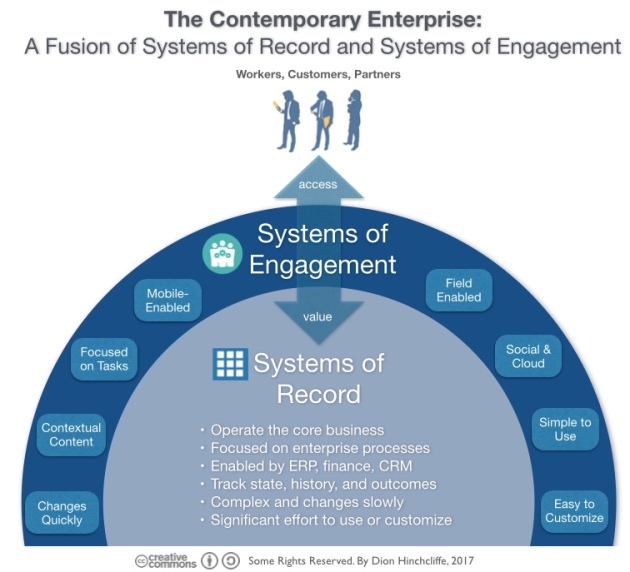It’s Time to Transform ERP into a System of Engagement
January 12, 2017 Leave a comment
The IT industry has steadily been moving beyond its roots in data management and record keeping for a few decades now, approximately since the advent of corporate e-mail. As I’ve tracked over the years, this trend is more broadly known as the shift from systems of record to systems of engagement. Over the years, we’ve witnessed how the value of IT systems grows dramatically when they focus as much on connecting people and systems together with as little friction as possible, as they do on storing and retrieving information.
We’ve also collectively learned as an industry that one-size-fits-all technology, especially in the enterprise, often ends up fitting the needs much fewer people than we expect. Put simply, despite all countless industry lessons learned, enterprise systems are still far too unwieldy, adapted poorly to individual users needs, difficult to use, and an impediment towards value creation, especially at the edges of our organization, where key business activities such as sales, marketing, service delivery, and customer care take place.
Today’s Successful Enterprise Systems Engage Effectively
In recent years, new highly personal forms of digital engagement have demonstrated a new path to us through the large scale global success of social media, use-anywhere smart mobile devices, and consumer apps that are essentially effortless to acquire and use.
When I look at most enterprise IT today however, it’s clear that the buyer is not the end-user but IT departments and other stakeholders who won’t have to use the systems themselves. The traditional ERP system, which runs much of the mission critical infrastructure, is possibly the worst offender and most in need of remediation in today’s era of highly consumable personal IT, which runs rings around most enterprise technology when it comes to usability, personalization, fitness to purpose, and responsive design.
Certainly, enterprise systems often have a very different set of goals than consumer IT, including much higher levels of security, more rigor in data structure and quality, complex operating requirements, and other factors that consumer IT simply doesn’t have to contend with. I’d argue these are, however, just not valid excuses for meeting the standards of modern IT systems when it comes to improving productivity, usefulness, and effective results in our organization. As I’ve long argued, we need to unclog the arteries of enterprise IT for competitive reasons as well as basic employee retention, given trends I’m seeing in end-user expectations of how IT systems should work.
At this point in IT industry evolution, I’d argue that the nature of the enterprise procurement process, along the roles of those typically charged with IT acquisition each conspire against the kinds of systems that users — and the business itself — would find more useful and productive in getting their work done. Plenty of evidence now shows that usability and accessibility have large benefits when it comes to getting results from enterprise IT.
An actual data point from the respected Nielsen Norman Group serves to make the point here: Allocating a mere 10% of the budget of your IT system to usability will approximately double the quality metrics for the system. Yet few projects allocate anything like this amount, especially to off-the-shelf systems.
Modernizing the ERP for Engagement by Augmenting It
So how can we overhaul the poor effectiveness of today’s ERP systems and bring the latest advances in today’s systems of engagement to bear to increase the poor usability of ERP systems that Jon Innes famously lamented back in 2010.
Given the slow rate of change in the usability and reach of ERP systems over the years, I’d now argue that we’re not going to see a major improvement in the design of ERP systems themselves. Instead, I now see that enterprises, which have invested enormous amounts in their existing enterprise systems, have little choice from most of the leading vendors. Instead, the typical ERP system should instead be augmented with the capabilities that will provide the full measure of value creation that was originally hoped for.
To this end, I’ve authored a new white paper that lays out my analysis that we’re about to enter a new era of enterprise IT. One that is not just more consumerized and highly usable, but focused on both the needs of the business and end-user both. By augmented ERP with effective systems of record, most organization can now take the power of today’s sophisticated ERP systems and extend them to wherever they are needed in a far more personalized, dynamic, and focused way.
As a new generation of IT thinking emerges, I now see that this will be the pattern of ERP and most enterprise IT systems, in that they will become a fusion of capable foundational systems of record and systems of engagement. The latter will either be purpose-built or developed by a new generation of enterprise IT companies that understand the new generation of IT, consumerization, design thinking, and usability on top of traditional IT requirements.
Credit: I’d like to thank Capriza for making my time available for the research and analysis that went into this white paper, which is freely available for download.




























































